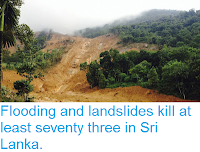At least one person has died and around ten small businesses have been completely destroyed following a landslide that hit the town of Ginigathhena in the Nuwaraeliya District of Central Province, Sri Lanka, on the morning of Friday 19 July 2019. The dead man has been identified as Kaldeen Mohamed Jamaldeen, 64, the owner of an electrical appliance shop. The businesses lost are reported to include several grocery stores, vegetable stalls, two restaurants, a salon and a shop selling ornaments. The area had previously been identified as being at a high risk of landslides by the Sri Lankan National Building Research Organisation, which recommended the area be evacuated and the shops relocated, though it is unclear if the shopkeepers were offered any help to do this.
Rescue workers searching the debris beneath the 19 July 2019 Ginigathhena landslide. Daily News.
The incident happened amid heavy rain associated with the Sri Lankan summer monsoon,
which lasts from May to October, typically bringing around 400 mm of rain
to many parts of the country in an average year. Landslides
are a common problem after severe weather events, as excess pore water
pressure can overcome cohesion in soil and sediments, allowing them to
flow like liquids. Approximately 90% of all landslides are caused by
heavy rainfall.
Onlookers above the scene of the 19 July 2019 Ginigathhena landslide. The shops destroyed would formerly have stood in the foreground of this image, facing onto the visible road. Colombo Gazette.
Monsoons
are tropical sea breezes triggered by heating of the land during the
warmer part of the year (summer). Both the land and sea are warmed by
the Sun, but the land has a lower ability to absorb heat, radiating it
back so that the air above landmasses becomes significantly warmer than
that over the sea, causing the air above the land to rise and drawing in
water from over the sea; since this has also been warmed it carries a
high evaporated water content, and brings with it heavy rainfall. In the
tropical dry season the situation is reversed, as the air over the land
cools more rapidly with the seasons, leading to warmer air over the
sea, and thus breezes moving from the shore to the sea (where air is
rising more rapidly) and a drying of the climate.
Diagrammatic representation of wind and rainfall patterns in a tropical monsoon climate. Geosciences/University of Arizona.
See also...
Follow Sciency Thoughts on
Facebook.









